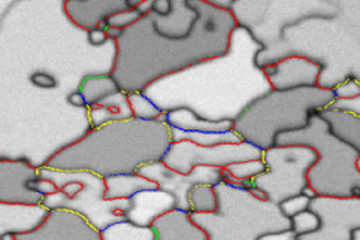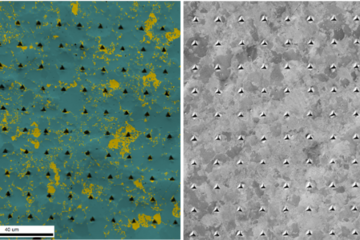All genres
481.
Poster
Microstructural investigation of solvothermally grown CuInS2. IAM Nano, Hamburg, Germany (2015)
482.
Poster
Electron microscopy studies of WO3-x based anodes for high temperature polymer electrolyte membrane fuel cells. IAM Nano 2015, Hamburg, Germany (2015)
483.
Poster
Degradation analysis of high temperature polymer electrolyte membrane fuel cells via electron microscopic techniques. TEM-UCA European Summer Workshop, Cadiz, Spain (2015)
484.
Poster
Electron microscopy investigation of solid state dewetted epitaxial Al thin films on sapphire. International Workshop on Advanced and In-situ Microscopies of Functional Nanomaterials and Devices (IAMNano 2015), Hamburg, Germany (2015)
485.
Poster
Investigation of solid state dewetting phenomena of epitaxial Al thin films on sapphire using electron microscopy. TEM-UCA: Transmission Electron Microscopy of Nanomaterials - European Summer Workshop (TEM-UCA 2015), Cádiz, Spain (2015)
486.
Poster
The Effect of Different Au Nanoparticles on the Water-Splitting Performance of Au-TiO2/FTO Layers. IAM Nano 2015, Hamburg, Germany (2015)
487.
Poster
Characterization of Mo2BC thin films by transmission electron microscopy methods. 2nd International Workshop on TEM Spectroscopy, Uppsala, Sweden (2015)
488.
Poster
Temperature induced faceted hole formation in epitaxial Al thin films on sapphire. 8th International Conference on High Temperature Capillarity (HTC-2015), Bad Herrenalb, Germany (2015)
489.
Poster
Three-Dimensional Analysis of Photoelectrodes by FIB Sectioning. nanoGe Solar Fuel Conference 15, Mallorca, Spain (2015)
490.
Poster
Nanostructure and micromechanical properties of Mo2BC thin films. IAMNano 2015 Hamburg: International Workshop on Advanced and In-situ Microscopies of Functional Nanomaterials and Devices, Hamburg, Germany (2015)
491.
Poster
Transmission electron microscopic characterization of TiO2/NbxOy core-shell nanowires. Autumn School on Microstructural Characterization and Modelling of Thin-Film Solar Cells, Werder, Germany (2014)
492.
Poster
Copper indium disulfide films synthesized with L-cysteine. Autumn School on Microstructural Characterization and Modelling of Thin-Film Solar Cells, Werder, Potsdam, Germany (2014)
493.
Poster
Solid state dewetting phenomena of epitaxial Al thin films on sapphire (α-Al2O3). 2nd International Multidisplinary Microscopy Congress (InterM 2014), Oludeniz, Fethiye, Turkey (2014)
494.
Poster
TEM Studies of Noble Metal Nanoparticles on TiO2. SPP 1613 Annual Meeting, Darmstadt, Germany (2014)
495.
Poster
Electron microscopic investigation of TiO2/NbxOy core-shell nanowires for application in hybrid solar cells. E-MRS Spring Meeting 2014, Lille, France (2014)
496.
Poster
TiO2/CuInS2 heterostructures for solar cell applications. E-MRS Spring Meeting, Lille, France (2014)
497.
Poster
Investigation of high-temperature polymer electrolyte membrane fuel cells by electron microscopy methods. CENS Workshop “Nanosciences: Great Adventures on Small Scales”, Venice, Italy (2013)
498.
Teaching
Atomare Charakterisierung von Werkstoffen. Lecture: WS 2024/2025, Heinrich-Heine Universität Düsseldorf, October 26, 2024 - February 12, 2025
499.
Teaching
Moderne Material- und Werkstoffcharakterisierung: Vom Atom zum Bauteil. Lecture: SS 2024, RWTH Aachen University, 2024-04 - 2024-07
500.
Teaching
Atomare Charakterisierung von Werkstoffen. Lecture: WS 2023/2024, Heinrich-Heine Universität Düsseldorf, October 26, 2023 - February 12, 2024











